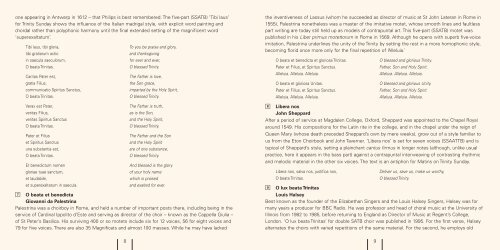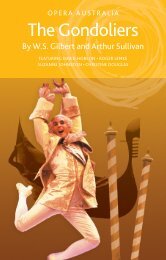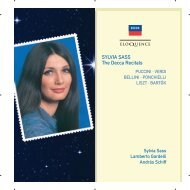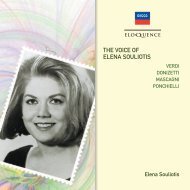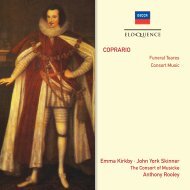You also want an ePaper? Increase the reach of your titles
YUMPU automatically turns print PDFs into web optimized ePapers that Google loves.
one appearing in Antwerp in 1612 – that Philips is best remembered. The five-part (SSATB) ‘Tibi laus’<br />
for <strong>Trinity</strong> Sunday shows the influence of the Italian madrigal style, with explicit word painting and<br />
chordal rather than polyphonic harmony until the final extended setting of the magnificent word<br />
‘superexaltatum’.<br />
Tibi laus, tibi gloria,<br />
tibi gratiarum actio<br />
in saecula saeculorum,<br />
O beata Trinitas.<br />
Caritas Pater est,<br />
gratia Filius,<br />
communicatio Spiritus Sanctus,<br />
O beata Trinitas.<br />
Verax est Pater,<br />
veritas Filius,<br />
veritas Spiritus Sanctus<br />
O beata Trinitas.<br />
Pater et Filius<br />
et Spiritus Sanctus<br />
una substantia est,<br />
O beata Trinitas.<br />
Et benedictum nomen<br />
gloriae tuae sanctum,<br />
et laudabile,<br />
et superexaltatum in saecula.<br />
8<br />
To you be praise and glory,<br />
and thanksgiving<br />
for ever and ever,<br />
O blessed <strong>Trinity</strong>.<br />
The Father is love,<br />
the Son grace,<br />
imparted by the Holy Spirit,<br />
O blessed <strong>Trinity</strong>.<br />
The Father is truth,<br />
as is the Son,<br />
and the Holy Spirit,<br />
O blessed <strong>Trinity</strong>.<br />
The Father and the Son<br />
and the Holy Spirit<br />
are of one substance,<br />
O blessed <strong>Trinity</strong>.<br />
And blessed is the glory<br />
of your holy name<br />
which is praised<br />
and exalted for ever.<br />
7 O beata et benedicta<br />
Giovanni da Palestrina<br />
Palestrina was a choirboy in Rome, and held a number of important posts there, including being in the<br />
service of Cardinal Ippolito d’Este and serving as director of the choir – known as the Cappella Giulia –<br />
of St Peter’s Basilica. His surviving 400 or so motets include six for 12 voices, 56 for eight voices and<br />
79 for five voices. There are also 35 Magnificats and almost 100 masses. While he may have lacked<br />
the inventiveness of Lassus (whom he succeeded as director of music at St John Lateran in Rome in<br />
1555), Palestrina nonetheless was a master of the imitative motet, whose smooth lines and faultless<br />
part writing are today still held up as models of contrapuntal art. This five-part (SSATB) motet was<br />
published in his Liber primus motettorum in Rome in 1569. Although he opens with superb five-voice<br />
imitation, Palestrina underlines the unity of the <strong>Trinity</strong> by setting the rest in a more homophonic style,<br />
becoming florid once more only for the final repetition of ‘Alleluia.’<br />
O beata et benedicta et gloriosa Trinitas.<br />
Pater et Filius, et Spiritus Sanctus.<br />
Alleluia. Alleluia. Alleluia.<br />
O beata et gloriosa Unitas.<br />
Pater et Filius, et Spiritus Sanctus.<br />
Alleluia. Alleluia. Alleluia.<br />
9<br />
O blessed and glorious <strong>Trinity</strong>.<br />
Father, Son and Holy Spirit.<br />
Alleluia. Alleluia. Alleluia.<br />
O blessed and glorious Unity.<br />
Father, Son and Holy Spirit.<br />
Alleluia. Alleluia. Alleluia.<br />
8 Libera nos<br />
John Sheppard<br />
After a period of service at Magdalen College, Oxford, Sheppard was appointed to the Chapel Royal<br />
around 1549. His compositions for the Latin rite in the college, and in the chapel under the reign of<br />
Queen Mary (whose death preceded Sheppard’s own by mere weeks), grow out of a style familiar to<br />
us from the Eton Choirbook and John Taverner. ‘Libera nos’ is set for seven voices (SSAATTB) and is<br />
typical of Sheppard’s style, setting a plainchant cantus firmus in longer notes (although, unlike usual<br />
practice, here it appears in the bass part) against a contrapuntal interweaving of contrasting rhythmic<br />
and melodic material in the other six voices. The text is an antiphon for Matins on <strong>Trinity</strong> Sunday.<br />
Libera nos, salva nos, justifica nos,<br />
O beata Trinitas.<br />
Deliver us, save us, make us worthy,<br />
O blessed <strong>Trinity</strong>.<br />
9 O lux beata Trinitas<br />
Louis Halsey<br />
Best known as the founder of the Elizabethan Singers and the Louis Halsey Singers, Halsey was for<br />
many years a producer for BBC Radio. He was professor and head of choral music at the University of<br />
Illinois from 1982 to 1985, before returning to England as Director of Music at Regent’s College,<br />
London. ‘O lux beata Trinitas’ for double SATB choir was published in 1995. For the first verse, Halsey<br />
alternates the choirs with varied repetitions of the same material. For the second, he employs old


